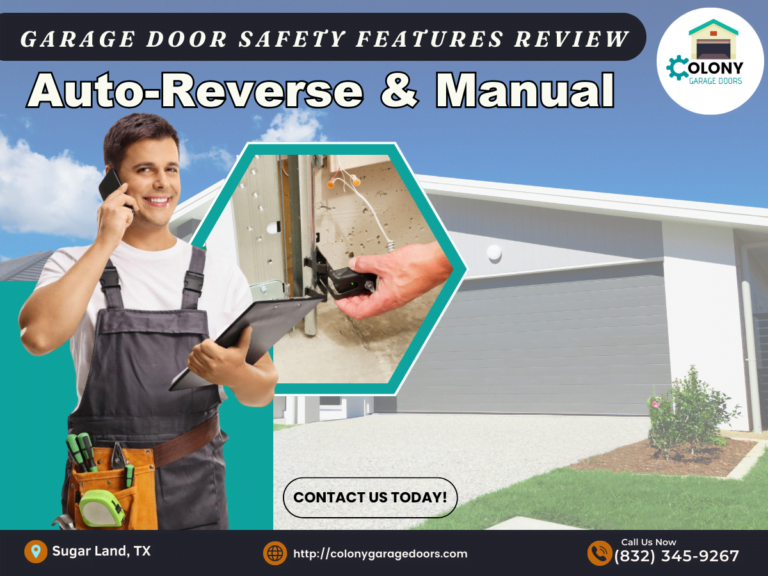Garage Door Safety Features Review: Auto-Reverse & Manual
Stay safe with Colony Garage Doors’ review of garage door safety features like auto-reverse sensors, manual controls, and regular maintenance tips!

Welcome to Colony Garage Doors, your go-to expert for garage door repair and installation in Sugar Land, TX! Today, we’re diving into a crucial topic: Garage Door Safety Features. We all want our homes to be safe and secure, and a well-functioning garage door plays a big role in achieving that.
Imagine this: it’s a sunny Saturday morning in Sugar Land, and you’re planning to spend the day with your family at the Houston Museum of Natural Science at Sugar Land. You hit the button to open your garage door, and the door suddenly stops mid-way. Your peaceful weekend is in jeopardy. Sound familiar?
In this post, we’ll explore some crucial safety features of modern garage doors, like auto-reverse sensors and manual control, and why regular maintenance is essential for your safety and peace of mind.
Auto-Reverse Sensors: Your First Line of Defense
What Are Auto-Reverse Sensors?
Auto-reverse sensors are the superheroes of garage doors. They use photoelectric eyes (aka infrared sensors) to detect any obstruction in the door’s path. If something blocks the sensors, the door automatically stops and reverses, preventing injury or damage.
How Do They Work?
- Infrared Light Beam: Two sensors mounted six inches above the ground send an infrared light beam across the door’s opening.
- Detection Mechanism: If the beam is interrupted by an object, the sensors send a signal to stop the door and reverse its direction.
- Prevention: They help prevent accidents, particularly protecting children and pets from getting hurt.
Why Are They Important?
Auto-reverse sensors aren’t just convenient—they’re required by law for all garage door openers manufactured after 1993. If your garage door opener is older than that, it’s time to consider an upgrade for safety’s sake!
Manual Control Features: Stay in Control When Power Goes Out
Emergency Release Cord
Ever had a power outage and couldn’t open your garage door? That’s where the emergency release cord comes in handy. This red cord hangs from the trolley and disengages the opener, allowing you to operate the door manually.
How To Use It
- Locate the Cord: Find the red cord hanging from the trolley.
- Pull Down: Pull the cord down to release the trolley from the opener.
- Lift the Door: Manually lift the door to open it.
- Reconnect: Once power is restored, close the door and pull the cord down and towards the door to re-engage the opener.
Stay Safe!
While the emergency release cord is a helpful feature, use it with caution. A garage door without the support of the opener can be quite heavy, so make sure you can handle it safely or have a professional inspect and balance the door.
Importance of Regular Maintenance
Regular maintenance can be the difference between a smoothly functioning garage door and a Saturday morning emergency. Here’s why it’s crucial:
- Prevent Costly Repairs: Catch small issues before they become expensive problems.
- Extend Lifespan: Properly maintained doors and openers last longer.
- Enhance Safety: Ensure all safety mechanisms like auto-reverse sensors and manual controls are working.
Maintenance Checklist
Here’s a quick list of maintenance tasks to keep your garage door safe:
- Test Auto-Reverse Sensors: Place an object (like a cardboard box) in the door’s path and check if it reverses.
- Inspect Springs and Cables: Look for signs of wear and tear.
- Lubricate Moving Parts: Apply lubricant to hinges, rollers, and tracks.
- Tighten Hardware: Check and tighten all bolts and brackets.
- Balance Check: Disconnect the opener and manually lift the door. If it doesn’t stay halfway open, the springs may need adjustment.
A Story of Timely Garage Door Repair
The Petersons’ Garage Door Drama
Meet the Petersons, a family of four living near the Sugar Land Town Square. One evening, Mr. Peterson noticed their garage door wasn’t closing all the way. It would stop mid-way and reverse itself. They called us at Colony Garage Doors for help.
Upon inspection, we found that the sensors were misaligned. We quickly realigned them and tested the door. The door closed perfectly, and the Petersons felt reassured that their auto-reverse sensors were functioning correctly.
The Takeaway
It’s easy to overlook the small details, but even a slight misalignment of your sensors can lead to big problems. Regular maintenance and timely garage door repair are essential to ensure your garage door stays safe and reliable.
FAQs on Garage Door Safety Features
Q1: How often should I test my garage door’s safety features?
A: It’s a good idea to test your garage door’s auto-reverse sensors and manual controls at least once a month. Regular checks can help catch issues early.
Q2: How do I know if my garage door needs repair or replacement?
A: If your garage door is making strange noises, moving unevenly, or not responding to the opener, it’s time to call a professional. For older doors (15+ years), consider a replacement.
Q3: Can I fix garage door issues myself?
A: While you can handle basic maintenance like lubrication and tightening screws, leave repairs involving springs, cables, or sensors to professionals. These components can be dangerous to handle.
Q4: Do I really need an annual maintenance check?
A: Absolutely! Annual maintenance ensures your garage door is safe, reliable, and ready for emergencies.
Famous Sugar Land Places & Garage Door Safety
- Houston Museum of Natural Science at Sugar Land: Don’t let garage door issues ruin your day at this fascinating museum. Regular maintenance keeps your weekend plans intact.
- Sugar Land Town Square: Before heading out for shopping and dining, ensure your garage door functions smoothly with our garage door repair services.
- Smart Financial Centre: Enjoy your concert without worries by ensuring your garage door is safe and secure.
Conclusion
Your garage door is more than just an entrance—it’s a safety feature for your home. Don’t let a malfunction ruin your plans or put your loved ones at risk. Colony Garage Doors is here to help with:
- Garage Door Installation: Upgrade to a modern, safe door today.
- Residential & Commercial Garage Door Repair: Whether it’s a home or business, we’ve got you covered.
- Emergency Garage Door Repair: Sudden issues? We’ll be there in no time.
Get in touch with us today to schedule a safety check or repair! Call Colony Garage Doors at (832) 345-9267 or visit our website to book your appointment.
